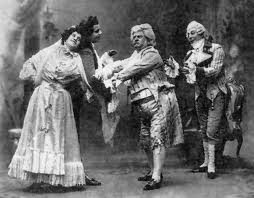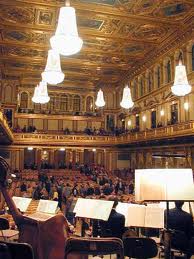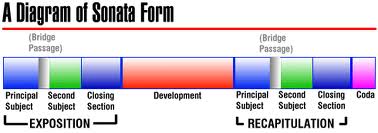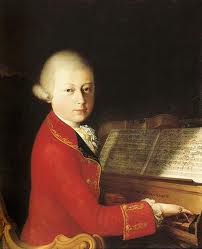4.5- Classical Music
Introduction to Classical Music

In music, the style of music of the 18th Century is not divided into two very distinct styles like art and architecture. That is why for simplicity sake we tend to generally call this era the Classical era.
Overview of Classical Music
The century starts with music for aristocratic patrons and a “gallant’ style during the classical era
[audio:onecohesivestyle.mp3]
- A growth of public concerts [audio:change-audienceandstructure.mp3]
- A demand from the middle class for music that is accessible and recognizable, yet serious
- Composers begin to break away from aristocratic patrons
- Less complex than Baroque style music
- Melody driven music
- Homophonic texture preferred over polyphonic texture
Birth of the Symphony
A performing group AND a form of music
- 1st Movement — fast and generally dramatic — usually in sonata allegro form
[audio:firstandlastmovement.mp3] - 2nd Movement — slow and contemplative — sometimes a theme and variation, or rondo form
[audio:secondmovement.mp3] - 3rd Movement — livelier and usually based on dance music like a minuet and trio
- 4th Movement — again, fast, but lively and happy.
Sonata
A style of work
[audio:sonatathework.mp3]
An instrumental piece for a keyboard instrument, or a solo instrument accompanied by a keyboard instrument
Started as a 3 movement work, and transformed into a 4 movement work AND a way to organize a movement of a symphony movement
[audio:sonatatheform.mp3]
Exposition – A main melody, maybe even a second contrasting melody
Development — a creative exploration of the first melody (and second melody too)
Recapitulation — The main melody is returned to and wraps things up
Opera and Concertos are still popular

Development of Opera Buffa — or Comic Opera
httpv://www.youtube.com/watch?v=fNpFKjKf-l8&feature=related
“Come scoglio imoto resta” from Mozart’s Cosi Fan Tutte
The Piano is Invented
[audio:piano.mp3]
- Evolved from the harpsichord and clavichord
- The strings are “struck’ with hammers
- Ability to play loud and soft
- The instrument continued to evolve
Supplementary video clip
httpv://www.youtube.com/watch?v=63snnLQqBLQ
The Composers
Franz Joseph Haydn 1732-1809
- Raised as a choirboy
- Served as a court musician for almost 30 years to Prince Esterhazy in Hungary
- A musical servant, required to compose, perform and rehearse the orchestra
- Met with Mozart regularly when he traveled to Vienna
- Composed numerous symphonies, and refined the form
- Called “Papa Haydn’ because he refined the symphony, string quartet and sonata.
- After the death of Prince Esterhazy he traveled and had a successful career as a freelance composer.
- Taught Beethoven — unsuccessful relationship
- Popular Works — Surprise Symphony
httpv://www.youtube.com/watch?v=bNd-Hbz0Hm0
Wolfgang Amadeus Mozart 1756-91
- Child prodigy — began composing at age 5
- Taught by his father, an accomplished performer and composer
- Tour European courts as a performing child “star’
- Suffered from illness and depression
- Had trouble keeping a court appointment
- Was very popular in Vienna, particularly his operas
- Wrote both serious opera and comic opera
- Combined spoken dialoges and areas, duets and ensemble works creating “singspiel’
- Most opera was written in Italian, Mozart wrote some in German as well
- Wrote over 600 works — symphonies, concertos, chamber music, choral works
- Died at 35 — buried in an unmarked pauper’s grave
Popular work — 40th Symphony — orchestral
httpv://www.youtube.com/watch?v=Ql_9F6pEJw0
Eine Kleine Nachtmusik — chamber music
httpv://www.youtube.com/watch?v=T8v-M7ZotVE
Queen of the Night Aria from The Magic Flute
httpv://www.youtube.com/watch?v=C2ODfuMMyss
Ludwig Van Beethoven 1770-1827
- Born in Germany, but had a career in Vienna
- Piano prodigy
- Had a successful career as a composer by the time he was 30
- Remained a freelance artist — the first composer to do so
- Helped by a number of patrons
- Supported himself though composing, performing and publishing
- Started losing his hearing in his 20’s, and was profoundly deaf by 1815
- Continued to compose, even though he could not hear
- Three distinct periods
- First Period — until 1802
- Wrote conventionally, following Haydn and Mozart
- Heroic Period 1803-14
- Works become more dramatic and longer in length
- His famous 5th Symphony is from this period
- Final Period 1815-27
- Explored new territory, departing from Classical constraints
- His greatest symphony — 9th Symphony is considered the first symphony of the Romantic era
Supplemental Link — The Genius of Beethoven
httpv://www.youtube.com/watch?v=E_nqi06Dl3c
Popular Work — 5th Symphony
httpv://www.youtube.com/watch?v=N6K_IuBsRM4
For a fun look at this work, and some information on sonata form
PDQ Bach’s Beethoven’s 5th
httpv://www.youtube.com/watch?v=f0vHpeUO5mw





 |
|
No. 1 — June 7th, 2012 at 8:52 pm
[…] Kljaich, Lisa J. “Art Music Theater F200.” 4.5- Classical Music. University of Alaska Fairbanks. Web. 07 June 2012. https://amtf200.community.uaf.edu/2009/04/24/04-music-3/ […]
No. 2 — June 24th, 2012 at 1:05 am
[…] https://amtf200.community.uaf.edu/2009/04/24/04-music-3/ Share this:TwitterFacebookLike this:LikeBe the first to like this. This entry was posted in Uncategorized. Bookmark the permalink. ← Blog #2-Baroque […]
No. 3 — October 13th, 2012 at 12:49 am
[…] As the middle class became larger and larger, they had a more disposable income, which means they had more money to spend on entertainment, namely concerts and theaters. Since the middle class now had more money to spend on entertainment, it created a shift in the entertainment industry of the time. Many composers started to become free-lancer and independent artists. By becoming independent and working for themselves, it opened up the doors to create their own pieces that were now accessible to the middle class; this created a growth in the amount of public concerts. Many composers could now make a living by creating their own pieces that the middle class would gladly listen too, instead of catering to desires and needs of the upper class, who used to be their only financial supporters. Beethoven was one of the first composer’s to become a free-lance artist. He supported himself by composing, performing and publishing. His 5th Symphony came in his second distinct period, his Heroic Period, which consisted of works that were more dramatic and longer in length. (https://amtf200.community.uaf.edu/2009/04/24/04-music-3/) […]
No. 4 — January 28th, 2013 at 10:06 pm
[…] [3] Kljaich, Lisa J. “Art Music Theater F 200.†4.5- Classical Music. University of Alaska Fairbanks. Web. 24 January 2013. https://amtf200.community.uaf.edu/2009/04/24/04-music-3/ […]
No. 5 — March 8th, 2013 at 7:49 am
[…] <https://amtf200.community.uaf.edu/2009/04/24/04-music-3/> […]
No. 6 — March 16th, 2013 at 1:59 am
[…] https://amtf200.community.uaf.edu/2009/04/24/04-music-3/ […]
No. 7 — October 18th, 2013 at 6:34 am
[…] 5. https://amtf200.community.uaf.edu/2009/04/24/04-music-3/ […]
No. 8 — October 19th, 2013 at 5:40 pm
[…] https://amtf200.community.uaf.edu/2009/04/24/04-music-3/ […]
No. 9 — January 10th, 2014 at 9:43 am
I just now cannot leave your website just before indicating that I very treasured the common facts an individual offer your invitees? Is usually going to be yet again often so as to take a look at brand-new discussions
No. 10 — August 11th, 2014 at 8:49 pm
Hey there! I could have sworn I’ve been to this website before
but after reading through some of the post I realized it’s new to me.
Anyhow, I’m definitely happy I found it and I’ll be bookmarking and checking
back often!
No. 11 — September 5th, 2014 at 3:52 am
My partner annd I absolutely love your blog and find a lot of your
post’s too be precisely what I’m looking for. Do you ofer guest writers to write content available
for you? I wouldn’t mind creating a post or elaborating on a lot of the subjrcts youu write in relation to here.
Again, awesome site!
No. 12 — September 5th, 2014 at 10:58 am
Thanks for your comment! This blog is a “textbook” for a college course. If you are an artist and want to create a youtube commentary to add to this blog that would be a possibility.
No. 13 — October 17th, 2014 at 2:59 pm
[…] <https://amtf200.community.uaf.edu/2009/04/24/04-music-3/> […]